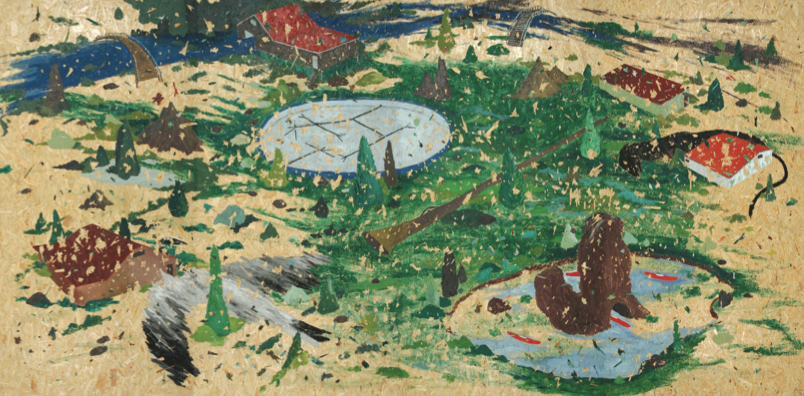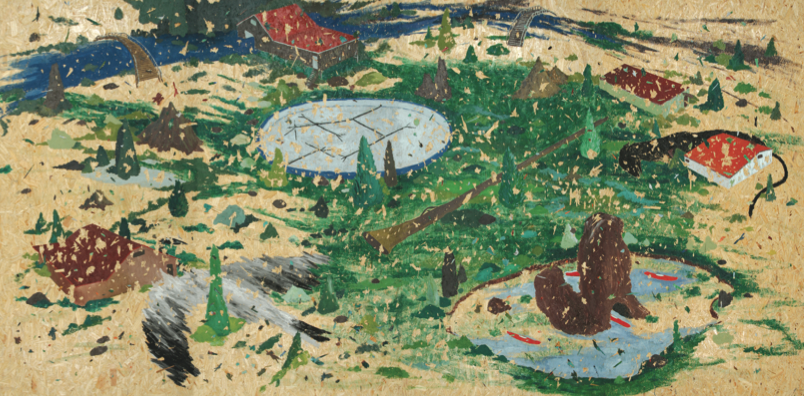Matías Duville
Open-air Stories. Drawings and Paintings
The name Matías Duville (Buenos Aires, 1974) started to appear shyly in the Argentine circuit at the beginning of the present decade. Duville was then living in Mar del Plata, a seaside city that painstakingly maintains considerable artistic activity, at a short distance from the epicenter based in Buenos Aires. In tune with his entourage, strongly linked to nature – Mar del Plata is synonymous with the most popular holiday beach in the country –, Duville created small-format landscapes on atypical supports. His drawings in ball-point pen on silk or in pencil on photographic album plastic pages comprised the first series he presented, stimulated by precocious admirers of his work such as artist Jorge Macchi (a luxury young teacher for a young artist in his formative years) or gallery owner Alberto Sendrós, who promptly incorporated him in his brand new Buenos Aires gallery in 2003.

When that same year he was one of the artists chosen by Guillermo Kuitca to be included in his select artist scholarship program, Duville consolidated his insertion in the local system, where he had the privilege of becoming one of the undisputed favorites of artists, curators and collectors. Today, barely five years later, Duville ́s career has easily expanded beyond the borders of Argentina, widening his horizon in every sense. But let us find out what his work consists in: to enter his universe is a little like embarking on a journey.
What first stands out in Duville is his passion for drawing, which he applies onto the different surfaces he explores. His is not a clean stroke, although its root is figurative: his hard, somewhat rough lines, which are not, however, childlike, depart from the canons of virtuosic representation but make it possible to clearly discriminate recognizable forms, constructions, places, situations, and objects. The second aspect that draws attention to his work when viewing it in perspective, overcoming the shifts in support and technique which have been habitual in recent years, is his tendency to generate landscapes, scenes that take place under the spell of the open air. But although they are slightly anchored in a realistic rendering, his images teem with strange details subsumed under a patina of normalcy that holds a promise, at first sight, of some kind of narrative adventure. It is only after a second gaze that these details burst out, completely rarifying the story, detaching it from its apparent correspondence with the real. Those landscapes, populated with houses, trees and cars do not speak of the world we know.
His work is marked by the recourse to drawing, the shape of the landscape, the deflection outside of reality and, in the fourth place, the nearness of an action. Sometimes his scenes appear to be the result of something that has just happened, and sometimes they seem to be awaiting, static and mute, that which is yet to come. In any case, they do not appear as fragments breaking loose from time but as fleeting fixations of times that pass, like moments stolen from larger contexts. Some of Duville ́s paintings verify the action as it takes place, and then we encounter colored cars flying through the air, spitted out from the heart of a twister in the work titled Huracán/Hurricane, or the wonderful drawings from the series Travelling, in which he intertwines roller-coasters with branches, cars with holes, trains with rocks, helicopters with waves. On other occasions the action is tacit, and it can be inferred from the inclination of a tree trunk which has been snapped by something strong enough to snap a trunk. The abysses, the islands, the craters, the objects suspended in impossible positions: everything conspires to transform these images into fragments of plots marked by the influence of cinematography, or by contemporary audiovisual culture in a wider context.
Duville ́s latest major solo show in Buenos Aires, at the end of 2007, revealed a mature artist, considering his undeniable youth, who after executing several murals, drawing with charcoal on paper or directly on the wall – as in Cover (MUSAC, Spain, 2007)– found a new, although less volatile, monumental-scale format. Under the title Una escena perdida/A lost scene, Duville presented a series of chipboard sheets with bases up to 7 meters long, anticipating a new dimension for his work. The way in which he manipulated the chipboard with drawings and brushstrokes, but also adhering splinters torn from the wooden board that served as plane, gave rise to a series of dazzling, simple, and at the same time hyperbolic pieces. These recent works also marked the reappearance of some birds and other animals that exalted the fictional, imaginative nature of the landscapes. The pitched-roof houses, small rural houses that do not seem to make reference to the archetypal imaginary of the Argentine countryside, but rather to the ideal farm standardized through American TV serials and movies, might be seen as film sets focused on panoramic shots in which an action was about to take place or had just taken place. The almost complete absence of human figures in Duville ́s work is another constant. The landscapes are generally deserted; trailers appear to have remained parked in the middle of nowhere for a long time; barn doors do not seem to have been opened in quite a while. They are ghost towns. Who might live in that single little house surrounded by pine trees on steep and sloping terrain, on the edge of the abyss? They are not houses that can be inhabited; they are part of another logic in which the coordinates seem to have gone crazy. It is not by chance that one of Duville ́s few anthropomorphic characters is a gigantic sleepwalker who walks in a wood or suddenly emerges from a lake: a considerable part of these fictions converge with the erratic logic of dreams. Objects are also rare, and they are generally associated to outdoor life...Slingshots, mosquito nets, flashlights. Duville ́s repertory is that of the camp, the survival kit required to remain outdoors. Trailers and smoking fires, mosquitoes and barely outlined animals coexist in a universe which draws as much on the cultural artifacts created to cope with the savage elements as on the savage elements themselves, and which finds its apotheosis in the physical-climatic-geographical phenomena depicted in the images. It is in the encounter between Nature and Culture – between forest and car – that the artist moves most fluently. And in addition to this, or on the sidelines, some extreme event takes place that dissolves the differences between both worlds, camouflaging the objects until they blend into the background of the landscape that surrounds them and enfolds them until it endows them with a different entity.
It is impossible to anticipate towards what new supports Matías Duville will turn in his role as an explorer. From those silks of his beginnings – fabrics generally used in filters for swimming pools, on which the artist drew with a ball-point pen and which he manipulated by moving the threads, generating extremely delicate wefts – to the gigantic murals on chipboards; from the drawings in oil crayons that disintegrate as they are pressed onto the paper, to the charcoal applied onto the wall, at this stage of his career Duville has already proved that working with a variety of materials only fosters his expressive ability, imposing new means and “limitations” that mark a particular treatment, a specificity, which results in the gestation of stories that may vary in length but are never insubstantial. While for some artists research on materials is merely a justification for changes in subject-matter, in the case of Duville each new material or support represents a new chance to give shape to the outdoor stories that seem to have always lived in his imagination.
Profile:
Matías Duville was born in Buenos Aires in 1974. He graduated as a Visual Arts Professor at the Martín Malharro Higher School of Visual Arts in Mar del Plata (1995-1998) and the Program of Visual Arts Workshops, CC ROJA UBA / KUITCA (2003-2005). He later studied under Jorge Macchi (2001-2002). He has been the recipient of numerous scholarships, among them, the Civitella Ranieri Fellowship, Perugia, Italy (2007) and the RIAA, International Artists Residence in Argentina, Ostende, Buenos Aires Province (2005). He has participated in numerous group shows in Argentina, Chile, Brazil, the United States, Spain and Germany, and has also presented eight solo shows.






